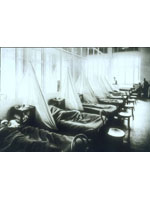WEB FOCUS
1918 influenza pandemic

In this focus:
In 1918, a highly virulent form of the influenza virus killed at least 20 million people worldwide. Understanding the origin of the virus that caused this pandemic has been a long-standing goal because of the risk that a similar virus could arise and devastate human populations today.
In this web focus, Nature presents the latest research from the completed genomic sequence of the 1918 flu virus alongside archive papers that have examined the containment, transmission and virulence of the influenza viruses. Produced with support from Retroscreen Virology Ltd, Queen Mary�s School of Medicine. As always, Nature carries sole responsibility for all editorial content. Image: National Museum of Health and Medicine, Armed Forces Institute of Pathology, Washington, D.C. (Reeve 14682).
Current research
LETTER
Aberrant innate immune response in lethal infection of macaques with the 1918 influenza virus
Darwyn Kobasa et al.
Nature 445, 319–323 (18 January 2007) | doi:10.1038/nature05495a
First Paragraph | Full Text | PDF | Supplementary Information
NEWS AND VIEWS
Influenza: Fatal immunity and the 1918 virus
Yueh-Ming Loo and Michael Gale, Jr et al.
Nature 445, 267–268 (18 January 2007) | doi:10.1038/445267a
NEWS
Concern as revived 1918 flu virus kills monkeys
Kerri Smith
Nature 445, 237 (18 January 2007) | doi:10.1038/445237a
LETTER
Genomic analysis of increased host immune and cell death responses induced by 1918 influenza virus
John C. Kash et al.
Nature advance online publication 27 September 2006 | doi:10.1038/nature05181
First Paragraph | Full Text | PDF | Supplementary Information
NEWS
The 1918 flu virus is resurrected
Special Report
Nature 437, 794–795 (05 October 2005) doi:10.1038/437794a
LETTER
Characterization of the 1918 influenza virus polymerase genes
Jeffrey K. Taubenberger et al.
Nature 437, 889–893 (05 October 2005) doi:10.1038/nature04230
LETTER
Large-scale sequencing of human influenza reveals the dynamic nature of viral genome evolution
Elodie Ghedin et al.
Nature AOP, (5 October 2005) doi:10.1038/nature04239
Top of page
Web links
Top of pageArchive
NEWS
Mice unlock mystery of Spanish flu
Michael Hopkin
news@nature.com (06 October 2004) doi:10.1038/041010-12
Deadly flu evades body's defences
John Whitfield
news@nature.com (26 August 2002) doi:10.1038/news020819-14
BOOK AND ARTS
Flu: The Story of the Great Influenza Pandemic of 1918 and the Search for the Virus that Caused It by Gina Kolata
Nicholas P. Restifo
Nature Medicine 6, 12 - 13 (2000) doi:10.1038/71463
Flu times two by Pete Davies
Brian W.J. Mahy
Nature Genetics 24, 111 (2000) doi:10.1038/72757
The Great Influenza: The Epic Story of the 1918 Pandemic by John M. Barry
Reviewed by John Oxford
Nature 429, 345-346 (27 May 2004) doi:10.1038/429345a
NEWS ANDS VIEWS
The makings of a killer
Peter Palese, Christopher F. Basler and Adolfo García-Sastre
Nature Medicine 8, 927 - 928 (2002) doi:10.1038/nm0902-927
The 1918 'Spanish' flu: pearls from swine?
Kennedy F. Shortridge
Nature Medicine 5, 384-385 (1999) doi:10.1038/7383
The Holy Grail of influenza virologists
John S. Oxford and Rod S. Daniels
Nature Medicine 5, 484-485 (1999) doi:10.1038/8364
New clues to the emergence of flu pandemics
Eric C.J. Claas and Albert D.M.E. Osterhaus
Nature Medicine 4, 1122-1123 (1998) doi:10.1038/2617
BRIEF COMMUNICATIONS
Avian flu: H5N1 virus outbreak in migratory waterfowl
H. Chen et al
Nature 436, 191-192 (July 14 2005) doi:10.1038/nature03974
First Paragraph | Full Text | PDF
ARTICLES
Strategies for containing an emerging influenza pandemic in Southeast Asia.
Neil M. Ferguson et al
Nature 437, 209-214 (2005) doi:10.1038/nature04017
First Paragraph | Full Text | PDF
Lethal H5N1 influenza viruses escape host anti-viral cytokine responses
Sang Heui Seo, Erich Hoffmann and Robert G. Webster
Nature Medicine 8, 950-954 (2002) doi:10.1038/nm757
First Paragraph | Full Text | PDF
LETTERS TO NATURE
Transmissibility of 1918 pandemic influenza
Christina E. Mills, James M. Robins and Marc Lipsitch
Nature 16, 904-906 (December 16 2004) doi:10.1038/nature03063
First Paragraph | Full Text | PDF
Enhanced virulence of influenza A viruses with the haemagglutinin of the 1918 pandemic virus
Darwyn Kobasa et al.
Nature 431, 703-707 (October 7 2004) doi:10.1038/nature02951
First Paragraph | Full Text | PDF

